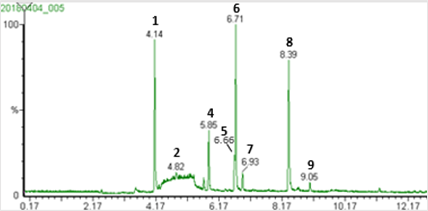|
Introduction
Over time, good working conditions have become more and more important in society. One of the critical parameters is the quality of air, and exposition to chemicals has to be reduced. Therefore, employers need to take measures in order to avoid taking a risk on workers’ health and safety.
One of the groups of compounds that has harmful effects on health is the one of Volatile Organic Compounds (VOCs). Because of this, legislation has been written, and threshold limit values (TLV) have been established, in order to reduce their emission. The threshold limit values of a chemical substance is the maximum concentration of this substance to which a worker can be exposed day by day without having any adverse effects.
In order to detect and quantify these molecules in the air, an analysis by ATD-GC-MS (Automated Thermal Desorption-Gas Chromatography-Mass Spectrometry) will be presented in this paper. The analysed air came from a UCBL (Claude Bernard University in Lyon) biochemistry laboratory.
Experimental conditions
Initially, ambient air was vacuumed up in a stainless tube filled with an adsorbent phase (appropriate for VOC analysis), for 30 minutes, and molecules were adsorbed by the phase. Then, they were desorbed using an Automated Thermal Desorber, which allowed them to be pre-concentrated in a trap tube. They were then injected together in the GC system, where they were separated. The separation was performed thanks to an average polar column. The vector gas used was helium, and a temperature gradient was applied.
The method used for detection was mass spectrometry, with an Electronic Impact (EI) source of ionization, and a quadrupole analyzer.
GC-MS method parameters are listed below:
Gas Chromatography
Column RTX-Vms Length (m)
Internal diameter (mm)
Film thickness (m)
Helium flow rate 1.3mL.min-1
Temperature gradient 40°C (1min)
40°C to 120°C (10°C.min-1)
120°C to 230°C (15°C.min-1)
230°C (15min)
Mass Spectrometry
Ionization mode EI+, 70eV
TIC Screening m/z=33 to m/z=500
Time 0min to 32.33min
SIR 1 : m/z= 41,42,43 4.76min to 4.92min
SIR 2 : m/z=55,56,69 8.32min to 8.48min
SIR 3 : m/z=47,48,87 8.32min to 8.48min
Scan Time 0.1 s
Inter-scan delay 0,05 s
The database used to identify the compounds was the NIST MS search.
Results
The chromatogram obtained after the analysis is shown in Figure 1. It is possible to identify eight different compounds (two of them, 1 and 9, were present on the blank tube chromatogram). Identification and a semi-quantification of these molecules is presented in Figure 2. This figure shows that VOCs were present in the laboratory’s air, but the concentrations of quantified compounds were largely inferior to the TLVs (for an 8h and a 15min sampling) imposed by legislation. This demonstrated that personnel in the biochemistry laboratory of UCBL work in a safe environment.
Conclusion
To conclude, this method allows ambient air samples to be analyzed, in order to verify that chemical compound concentrations are sufficiently low for workers to not be harmed during their work time. Moreover, it is a technique that, if it is adapted, can be used to identify and quantify other groups of compounds, and, therefore, it allows the concentrations of a very large amount of harmful compounds to be followed.
|
|

Figure 1 – Biochemistry laboratory’s air analysis chromatogram.

Figure 2 - Identification and semi-quantification of the compounds on the chromatogram on Figure 1.
|




